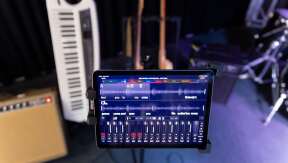This is a guest post from our friends at Use Your Ear. We think they offer a great method to combine with Jamzone and enjoy our app to its fullest. So we give them the stage for a few minutes, let them explain how they cracked the formula to efficiently teach ear training and how you can get started with it now.
TABLE OF CONTENT
1. Let's talk about ear training.
2. How our perception of musical pitch naturally works and develops.
3. Why most musicians have serious difficulties developing an intuitive connection to music.
3.1 Issues related to the interval method.
4. How we help musicians to successfully develop an intuitive connection to music.
4.1 With the Use Your Ear Video-Course, you'll get:
Let’s talk about ear training
Most musicians can not play by ear. But playing by ear separates the extraordinary musicians from the ordinary. It seems like musicians that play by ear have a talent they were born with because developing great musical hearing skills has always been a big struggle for the vast majority of musicians. Most have trouble:
- Quickly recognize melodies and chord progressions by ear and then either transcribe them or play them.
- Playing along with other musicians by ear rather than having to learn every bit of a song by rote memorization.
- Effortlessly singing or playing a melody perfectly on pitch.
- Intuitively improvising a good melody line over a chord progression.
It's clear that in order to have these skills we can't think rationally and make a lot of mental calculations. Instead, we have to rely on a mental system that allows us to think of notes and chords on an intuitive level; Just like we're able to effortlessly process and understand the meaning of words in a conversation.
In this post, we're going to clarify:
- How our perception of musical pitch naturally works and develops. This is a missing ingredient from traditional ear training methods.
- Why most musicians have serious difficulties developing an intuitive connection to music while following traditional ear training methods.
- How we help musicians to successfully develop an intuitive connection to music.
We are Leonardo Caminati and Matteo Calza. Our background includes working as professional musicians and music producers.
But things were not that great for us a few years back. We struggled mightily to develop ear training skills. So much so that at a certain point in our life it felt impossible for us to reach the level of musical proficiency that we desperately needed to make our dreams come true.
Traditional ear training methods did not work for us even after years of dedicated effort. They did not work for our friends either. Trying to learn songs by trial and error did not very well. It was slow and frustrating.
In desperation, we decided to dig into the science of how ear training skills develop. We were amazed by the depth and breadth of the research that had been done on how pitch and harmony are perceived. The discovery of the principles uncovered by rigorous scientific methods was unbelievably exciting. It was like finding gold!
Most surprising of all was that no one had interpreted the research results into an ear training method. We used what we learned to teach ourselves ear training. And it worked!
Then we taught our friends which led to teaching hundreds of paying students. We found that there is not a requirement for being born with talent. Some of our students initially had trouble with basic pitch matching. But those who followed our methods became successful. Based on our teaching experience we created an innovative ear training method that we call the "Use Your Ear Method".
The "Use Your Ear" method has already helped thousands of musicians to develop intuitive ear training skills. They are using their ear training skills to take their musical journey to levels beyond what they ever expected. This was possible because our course is a carefully constructed step-by-step method based on the science of how the perception of musical pitch naturally develops.
How our perception of musical pitch naturally works and develops.
The only way for us to effortlessly and intuitively perform the skills listed at the beginning of this post is to develop such a level of familiarity with the sensation of notes and chords (tension, resolution, stability, instability, happiness, sadness, etc.) that we can quickly recognize them or recall their precise sensation (thus their pitch) when singing or playing. That's how great musicians are able to get great musical performances on the spot without any effort whatsoever.
So the main question here is "How could we internalize the sensation of notes and chords?" but in order to answer that question we should answer this other question at first: Why does one note carry a sensation of resolution and another carries a sensation of tension? In other words, what is the main factor that allows a note to assume one feeling as opposed to another?
I suspect that those of you that are following traditional methods might have answered "the interval from one note to the next". But the scientific research and our years of experience tell us that the perception of the sensation that a note assumes does not really depend on the distance between that note and its surrounding notes. Instead, multiple scientific findings clearly show, the sensation depends 100% on the relationship between the note and the tonic note, the tonal center of the key. In other words, the sensation of a note depends on the harmonic function it assumes inside the key. This is a far more natural and intuitive way to perceive notes than intervals.
As you probably already know, we have 7 notes inside a given tonality, and each one of them corresponds to a specific degree of the scale. We can say that each degree of the scale assumes its own specific sensation, which is always the same independently from whether we're in the key of G, C, C#, Gb, or whatever.
For example, in the case of a major key, the tonic note always carries a feeling of resolution, the 7th degree always carries a sensation of tension, and so on, independently from the intervals that are being played melodically.
We can internalize these 7 different feelings just like if they were words so that we can recognize or recall them without any effort.
Similarly, you can apply this concept on chords, but unfortunately, we can't explain everything in this post otherwise it will definitely get too long.
In the video below you can find a much more in-depth explanation of everything we have said up to this point, including all the scientific studies that back this up.
Why most musicians have serious difficulties developing an intuitive connection to music.
Despite the popular myth of innate musical talent we can say that, in our experience, after teaching ear training to hundreds of students in 1 on 1 lessons (and being ear training students ourselves), everyone can develop a very intuitive connection and understanding of music, independently from their current level. In other words, these skills are 100% within the realm of normal human capabilities exactly like reading or writing. Everyone can learn to transcribe chords and melodies with ease IF....they follow an effective ear training approach.
Most musicians have serious difficulties developing an intuitive connection to music because they are practicing following ineffective ear training methods or without any methods at all.
As you know, there are many different traditional approaches to ear training, some rudimentary ones, and other more comprehensive ones but almost all of them rely, in one way or another, on the interval method (or interval thinking). The huge problem is that the interval method is entirely based on a wrong assumption, and thus it is seriously flawed and ineffective. In the next part of this post, we will dissect the 4 main problems related to the interval method and interval thinking in general.
If you're not familiar with the interval method then you're likely to be using some more rudimentary approaches, such as trying to learn songs by trial and error for example. In that case I suggest you watch a YouTube video where I thoroughly explain why learning songs by ear is likely to not help you at all in developing relative pitch skills. You can see it below.
Issues related to the interval method
- The interval method is based on an erroneous assumption. The underlying concept behind the interval method is that you internalize the sound of a particular interval so that you can instantly recognize that interval every time it plays in a real melody. However, our perception of musical pitch is context-dependent (as explained earlier).
This means that the same note, the same interval, the same chord, etc. assumes a totally different sensation (tension, resolution, etc.) depending on the function it assumes inside the tonality.
This totally explains why the basic assumption that "once you've learned an interval you can recognize it every time it plays" is wrong and that's not going to happen. Trying this method for years was extremely frustrating for us.
In the video below you can check out a practical example where I show how a major 3rd interval can assume 2 opposites sensations, and we could waste an entire month making other examples like that:
- The interval method doesn't promote an efficient way of thinking that we can easily and effortlessly apply in real musical contexts. For example, in order to recognize a 5 note melody using interval thinking we have to recognize each interval in between the notes. Thus we have to recognize 4 intervals in order to recognize a five-note melody, this means that a lot of mental calculations are needed and if we misinterpret 1 of the intervals then all the following notes will be wrong.
That's a very inefficient and risky way of thinking which is quite difficult to apply in real musical contexts where you have to figure out melodies and chords on the spot.
- The 3rd issue with the interval method is that it doesn't allow you to familiarize yourself with the sensations that notes and chords assume inside the tonality. As we've already explained each note or chord assumes a very specific feeling in the context of the key, and you should internalize these sensations in order to develop an intuitive connection to music. This way you will be able to intuitively recognize notes and chords in the same way you can recognize colors, for example: When you see the color blue, you don't have to think and doubt yourself "oh....is this blue? red? green?...". No, you know it's blue and you have no doubts about it. The same can happen with notes and chords and this is the kind of intuitive connection that makes you great at ear training.
Unfortunately, since interval exercises are by definition atonal exercises that don't have a context, you always practice them in the absence of a clear tonal center. That's a very big issue because it doesn't allow you to develop this very intuitive connection to music that you absolutely need in order to become musically proficient.
- The interval method inadvertently requires students to perform very difficult exercises from the very beginning of their learning process since it doesn't take into account how these skills develop and how our mind absorbs musical information. So it's not gradual at all.
As we were saying before, interval exercises require you to recognize notes without the clear presence of an underlying key, and this is a very advanced task for our mind to accomplish because our mind totally works in a tonal way.
Before we can recognize notes in the absence of a clear tonal context we need to master the ability to recognize notes in a simple tonal context. Doing the opposite will only produce a lot of frustration and no improvements. That is like trying to learn to run before being able to walk.
How we help musicians to successfully develop an intuitive connection to music.
That being said, let's now see how the Use Your Ear method solves the main issues related to the interval approach:
- Solution to issue n°1: The Use Your Ear method carefully takes into account that our perception of musical pitch is 100% context-dependent, and thus we only train in a contextual way. When practicing our exercises, you internalize how notes and chords sound in real musical contexts so that you can easily recognize them in real songs.
- Solution to issue n°2: The goal of the Use Your Ear method is to allow you to recognize notes and chords in a very fast and intuitive way so that you can easily apply your skills in real musical contexts, where you don't have time to think and make mental-calculations. We provide you with clear and in-depth explanations on the exact thought process that you should adopt in order to intuitively recognize chords, melodies or perform other ear training tasks on the spot. You will learn how to think in the most efficient way possible in order to accomplish the task at hand.
- Solution to issue n°3: Every exercise included in the Use Your Ear method is played or practiced in a tonal context. So each exercise will help you familiarize yourself with the sensations that notes and chords assume inside the tonality. As you move to more advanced sections of the course your familiarity with notes and chords will further strengthen and reinforce itself, thus it will become more and more intuitive for you to recognize them.
- Solution to issue n°4: Relative pitch skills develop in a very specific order like most other complex skills do. Just think of learning to read...you start by learning the alphabet, then you learn the sounds of syllables, then you start reading words, then sentences, and so on. Each skill is developed one on top of the other, you can't expect a child to be able to read-only by giving a book in his hands and nothing else. Thanks to years of experience teaching ear training to students 1 on 1, we've developed an in-depth knowledge of the exact order in which relative pitch skills develop. Thus, we've created the first ear training method that includes a real, 100% effective step-by-step path. All the exercises that you would find in our method are progressively challenging. You start on very simple exercises, that allow you to develop the very basic skills that are needed to accomplish the next exercises and so on. This way you'll be able to gradually accomplish very complex tasks (like recognizing melodies and chords in real-time), regardless of your current level. Moreover, our method includes benchmarks that allow you to easily understand whether an exercise is appropriate for your current level or not.
That being said, the Use Your Ear method is not only for people that were practicing intervals, it's much more than that. Generally speaking we can say that, if you'd like to:
...think of a melody in your head and be able to effortlessly play it on your instrument.
...stop wasting time and feeling frustrated by practicing tons of useless exercises, without seeing even the smallest noticeable improvement in return.
...get together with your bandmates and freely improvise or create songs just by following your imagination and creativity, without thinking about music theory or what the right pattern to play on your instrument is.
...develop a natural ability to sing melodies in tune without any mental effort whatsoever.
...listen to a song on your car radio and effortlessly transcribe it in your head while you're driving.
...feel spontaneous and free when you play music or sing.
...shut down that thought in your head that constantly tells you that you are not talented.
...become musically proficient and get your dream professional job in the music industry.
Then, the Use Your Ear method is exactly for you and you can access the entire method right now by subscribing to the Use Your Ear Relative-Pitch Video Course.
With the Use Your Ear Video-Course, you'll get:
- The right strategic approach to ear training: What to practice, when to practice it, how to practice it and what results to expect.
- The entire step-by-step series of concepts and exercises that will allow you to gradually develop your skills from beginner to advanced.
- Every in-depth explanation related to the perceptual mechanisms behind skills like pitch matching, melodic recognition, tonic recognition, chords recognition, musical memory, improvisation, etc.
- The specific series of exercises that will allow you to intuitively recognize melodies, chords and connect melodic and harmonic thoughts together.
- The specific series of exercises that will allow you to internalize more advanced musical elements such as chord inversions, non-diatonic chords, modulations (more commonly known as key shifts), modes, etc.
- Access to a great community of thousands of serious ear training students that are interested and committed to developing a great musical ear.
- All the PDF and high-quality audio exercises, created specifically for this new approach.
There is much more to say about our course and ear training in general but it's impossible for us to cover everything here. There is more free content you can see at our Youtube Channel.
If you have any questions don't hesitate to contact us from this page →
Lastly, we encourage you to check out what our students are getting from our course by watching the video below and also taking a look at this page →.
That's all for now, thank you very much for your attention.



